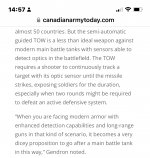GR66
Army.ca Veteran
- Reaction score
- 3,409
- Points
- 1,160
Ignoring the specifics of how the various Units and Sub-Units are structured I'd think that a reasonable goal for a country the size and wealth of Canada would be to be for our Army to be able to lead a Multi-National Division with a Canadian Divisional HQ and supporting elements plus a single Brigade with the other two Brigades being supplied by allied forces.
On mobilization we should be able to field and sustain a fully Canadian Division. We can debate what types of Brigades, how they are equipped, where they are deployed, whether elements are pre-positioned in various locations, etc., but overall in my opinion the above should be an achievable goal around which the other discussions should take place.
On mobilization we should be able to field and sustain a fully Canadian Division. We can debate what types of Brigades, how they are equipped, where they are deployed, whether elements are pre-positioned in various locations, etc., but overall in my opinion the above should be an achievable goal around which the other discussions should take place.


